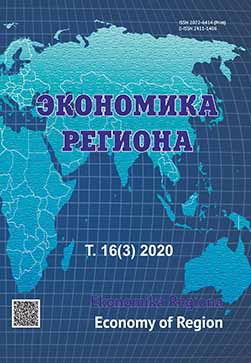Цифровизация промышленного производства в регионах России: пространственные взаимосвязи
Digitalisation of Industrial Production in the Russian Regions: Spatial Relationships
Author(s): Ilya Viktorovich Naumov, Julia Vladimirovna Dubrovskaya, Elena Viktorovna KozonogovaSubject(s): Economy
Published by: Институт экономики Уральского отделения Российской академии наук
Keywords: digital transformation; industrial enterprise; RFID-technology; migration flow matrix; Moran’s index; spatial autocorrelation; local index of spatial autocorrelation; spatial heterogeneity
Summary/Abstract: Digitalisation is a new global trend that significantly influences the economic and social development of various territorial systems (from municipal to macroeconomic level). We hypothesise that the digital transformation of industrial enterprises is becoming a key factor of territorial competitiveness that determines regional development prospects and the possibility of increasing the growth rate of the national economy. To substantiate this hypothesis, we examined the spatial relationships, which emerge when industrial enterprises introduce digital technologies at the regional level, as well as assessed the impact of digitalisation processes on the renewal of the human resource capacity of the regional industry. For analysing the digital modernisation of the regional industry, we used official statistics on the share of organisations using radio-frequency identification (RFID). We chose this particular indicator because RFID-technology is the closest to cyber-physical systems, which enable the so-called smart production (the main indicator of the fourth industrial revolution). Using the global and local Moran’s indexes and the migration matrix of spatial weights, we studied the spatial heterogeneity of the digital industry transformation across the Russian regions. Anselin’s local autocorrelation matrix was applied to analyse inter-regional relationships, which emerge when manufacturing enterprises use of digital technologies. The calculated negative spatial autocorrelation index proves that digitalisation processes in industrial production have a high spatial heterogeneity: only a small part of the regions is characterised by a high level of RFID use by manufacturing enterprises. Using the migration flow matrix of graduates, we revealed that the constituent entities of the Russian Federation differ not only in indicators of using digital technologies but also in attractiveness to young, highly qualified personnel. The results of the spatial analysis confirm that the introduction of smart production technologies by industrial enterprises significantly influences the progressive socio-economic development of territories. This conclusion opens up new topics for research, including the theory of regional economic growth and the issues of transformation of the digital space of the national economic system.
Journal: Экономика региона
- Issue Year: 16/2020
- Issue No: 3
- Page Range: 896-910
- Page Count: 15
- Language: Russian

